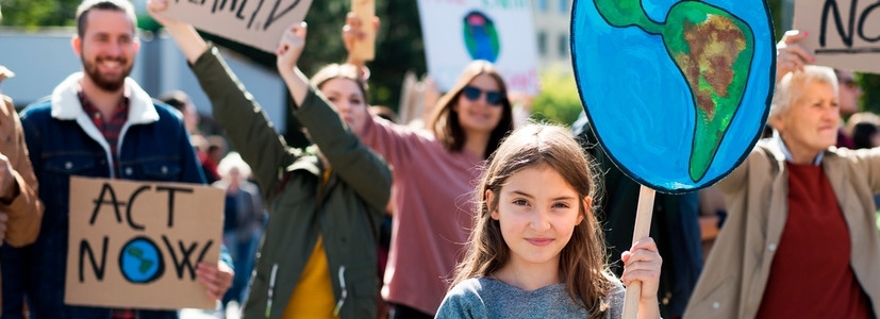
In Montreal, the 34th Meeting of Parties on the Montreal Protocol (MOP), dealing with ozone layer damage, just ended. This protocol is ratified by all countries in the world and is very successful. Shiming Yang, university lecturer and member of the Leiden University interdisciplinary programme Global Transformations and Government Challenges, explains why.
Hi Shiming, could you tell us a bit more about the MOP?
'The Montreal Protocol on Substances that Deplete the Ozone Layer, adopted in 1987, aims to protect the stratospheric ozone layer from chemicals that deplete it. Widely recognized as the most successful multilateral environmental agreement and the only one with universal ratification, it has phased out 98% of ozone-depleting substances (ODS) compared to 1990 levels. In 2016, the Montreal Protocol adopted its latest amendment, the Kigali Amendment, which aimed to phase-down hydrofluorocarbons (HFCs), a potent greenhouse gas (GHG), by more than 80 percent over the next 30 years. This will avoid more than 80 billion metric tons of carbon dioxide equivalent emissions by 2050 - avoiding up to 0.5° Celsius warming by the end of the century - while continuing to protect the ozone layer.'
'Countries and non-state stakeholders are now going beyond "just" protecting the ozone layer to maximize climate benefits achievable under the ozone regime.'
The adoption of the Kigali Amendment motivated the Montreal Protocol to expand its scope from an ozone treaty to a climate one. Countries and non-state stakeholders are now going beyond "just" protecting the ozone layer to maximize climate benefits achievable under the ozone regime. For example, the MOP-34 passed a decision to incorporate energy efficiency considerations in replenishing the Multilateral Fund, a decision to enhance energy efficiency while facing down HFCs. There were discussions to bring nitrous oxide, a fast-growing ODS but also potent GHG, under the regulation of the Montreal Protocol. Also, the MOP now discusses climate intervention, the "last resort against global warming", through methods like stratospheric aerosol injection (SAI). SAI aims to cool down the Earth by injecting aerosols into the upper air to reflect solar radiation that otherwise would add heat to the Earth. It is a highly controversial method because of its ethical implications and scientific uncertainty, hence has received little discussion at the UNFCCC.'
Why is the Montreal Protocol so successful?
'The Montreal Protocol is among the first multilateral environmental agreements that base policy actions on scientific findings. Its Scientific Assessment Panel (SAP) and Technology and Economic Assessment Panel (TEAP) gather experts on atmospheric science and the ODS sector, who produce scientific and technical knowledge in response to parties' requests and whose reports serve as foundations for relevant negotiations. This institutional design was adopted by the subsequent UNFCCC, but with limited success because it concerns much more sectors, which made it harder to forge consensus and build trust across sectors. Equally important was the North-South cooperation reflected in the Montreal Protocol institutions. It embodies the Common-but-Differentiated Responsibility Principle with the 10-year grace-period for developing countries' compliance and the Multilateral Fund, replenished every three years by industrialized countries. Commitments are being fulfilled, which enhanced trust among the participants.'
The adoption of the Kigali Amendment motivated the Montreal Protocol to expand its scope from an ozone treaty to a climate one. Countries and non-state stakeholders are now going beyond "just" protecting the ozone layer to maximize climate benefits achievable under the ozone regime. For example, the MOP-34 passed a decision to incorporate energy efficiency considerations in replenishing the Multilateral Fund, a decision to enhance energy efficiency while facing down HFCs. There were discussions to bring nitrous oxide, a fast-growing ODS but also potent GHG, under the regulation of the Montreal Protocol. Also, the MOP now discusses climate intervention, the "last resort against global warming", through methods like stratospheric aerosol injection (SAI). SAI aims to cool down the Earth by injecting aerosols into the upper air to reflect solar radiation that otherwise would add heat to the Earth. It is a highly controversial method because of its ethical implications and scientific uncertainty, hence has received little discussion at the UNFCCC.'
'I think a sectoral approach would be more efficient than trying to reach an overall agreement on climate change.'
What is the big difference between Montreal Protocol and the UNFCCC COP going on in Egypt right now?
'I think the biggest focus of this COP is on climate finance, especially on climate adaption and loss and damage, which are the primary concern for an ever-growing number of developing countries, but its urgency is not shared by all industrialized countries. The US$100 billion promised by 2020 failed to deliver, and without credible commitment from the global North, the trust between industrialized and developing countries are unlikely to re-build. Recovering from the pandemic, no country is in great shape to pay for climate actions beyond their borders.'
How do you think that the negotiations on climate change should be approached?
'I think a sectoral approach would be more efficient than trying to reach an overall agreement on climate change. Sectoral regimes, such as the Montreal Protocol, International Civil Aviation Organization, and the Minamata Convention on Mercury, are in great positions to reduce GHG emission of the corresponding sectors through direct or indirect measures. These regimes are industry-specific and attended by long-time state representatives and sectoral stakeholders. This setting induces trust-building and efficient communication for complex technical issues.'
Global Transformations and Government Challenges (GTGC) is een interdisciplinair onderzoeksprogramma van de Uiversiteit Leiden. Het netwerk van het programma bestaat momenteel uit meer dan 160 onderzoekers, werkzaam bij 6 faculteiten van de universiteit. GTGC onderzoekt hoe we wereldwijde veranderingen (zoals pandemieën, opwarming van de aarde en migratie) kunnen aanpakken op een democratische, effectieve, eerlijke, vreedzame en duurzame manier.
Bekijk de website van Global Transformations and Government Challenges






